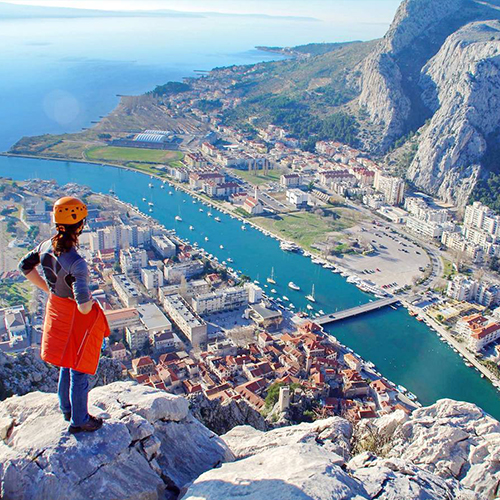Places to visit

Biokovo Nature Park
Biokovo is the mountain range you’ll see right as you walk out of your accommodation at Villa Sandra. Peaks reach over 1,500 metres and end at the sea. You can drive/ride up the mountainside via the Park Entrance and head up a 23km long road to the peak at Sv. Jure. Be sure to stop halfway at the Skywalk to get the best views in all of Dalmatia.

Imotski
Behind Biokovo, Imotski can be found close to the border of Bosnia and Herzegovina. The Imotski lakes are the main attractions here, including Crveno jezero (the Red Lake) which is the deepest Karst lake in Europe, and Modro jezero (the Blue Lake), a favourite bathing spot for the Imotski people.

Omiš
Situated on the mouth of the Cetina River, Omiš is known as the Pirate’s Lair because of its 12-13th Century inhabitants that controlled the seas all the way to Dubrovnik. The town is backed by sheer cliffs and rugged peaks, topped with the Mirabela Fortress (Peovica).

Split
Croatia’s 2nd largest city, Split is set in a unique location and has a great balance of modern and traditional Croatia. The Old Town contains spectacular Roman scenes including narrow streets, the Diocletian’s Palace, Cathedral of St. Dominus, as well as bars, restaurants and shops.

Trogir
The Old Town of Trogir is set on an island accessible by bridges from mainland Croatia and the larger island of Čiovo. The seaside promenade is lined with restaurants, bars and yachts, which is perfect for enjoying the nightlife.

Mostar
Mostar is a city in southern Bosnia and Herzegovina around 60km from the Croatian border, named after the bridge keepers (mostari) who guarded the Old Bridge (Stari most). A common destination for day-trippers, the city offers quaint cobblestone streets, restaurants and markets.

Dubrovnik
Dubrovnik is one of the most visited cities on the Adriatic and was inscribed to the UNESCO’s World Heritage Sites in 1987. The city is famous for its Stradun (the oldest street), the Minčeta fortified tower, and the city walls which you can walk along.

Šibenik
Known as a gateway to the Kornati Islands, Šibenik sits where the river Krka flows into the Adriatic Sea. The 15th-century stone Cathedral of St. James, decorated with 71 sculpted faces is the central feature of the city. It is also surrounded by a collection of 4 fortresses to keep out invaders – St. Nicholas’, St. Michael’s, St. John’s, and Barone.

Krka National Park
Krka National Park covers a total of 109km2 in the Šibenik-Knin County and contains a series of 7 waterfalls that drop 242m in altitude. As well as being able to follow magical nature trails through the falls, you can also visit archaeological sites and collections around the park.

Brač
You can get to the island of Brač by ferry (Jadrolinja or TP Line) from Makarska’s port. The island is known for its famous beach Bol and its stone façades. Some report that stone from Brač was used to renovate the White House in 1902!

Hvar
You can get to the island of Hvar by ferry (Jadrolinija or TP Line) from Makarska or Drvenik. The island itself can boast the most annual sunshine in all of Croatia, and the town of Hvar is decorated with a fortress, a cathedral, theatre, monastery, monuments, and beautiful old streets.

Korčula
You can get to the island of Korčula by ferry (Jadrolinija or TP Line) from either Brač, Dubrovnik, Hvar, Orebić or Split. People call the town of Korčula “Little Dubrovnik” because of its medieval squares, churches, palaces and houses. The layout of the town is designed to resemble fish bones to protect the town against sea winds.

Vis
You can get to the island of Korčula by ferry (Jadrolinija or TP Line) from either Makarska or Split. Because of its distance away from mainland Croatia, Vis offers richer natural beauty, traditions, history and cultural heritage. The island is known for its fishing and wine.


